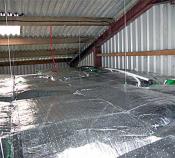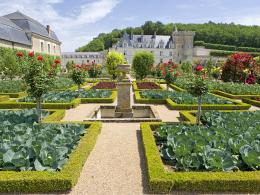Search
Login
Recommended
How to create your own garden from scratch? Planning a garden in a garden
To grow vegetables even on a small plot, you do not have to be an experienced gardener. You can easily make a garden and a garden with your own hands, combining them into one. First you need a plot in a sunny place, seeds, patience and a desire to grow your vegetables. And how to plan a garden, choose plants and transform a garden using vegetable crops, you will learn in detail from this article.
Content
- Choose a place for the garden
- Soil preparation
- Garden design video
- Seeds or Seedlings
- How to avoid mistakes when planting seeds and seedlings video
- We plant vegetables properly
- Vegetable bioprotection
Choose a place for the garden
Even a plot of 5 2 m may well be the beginning for your mini-garden in the garden. The main thing is not the area of \u200b\u200bthe garden, but its location. The place for vegetable plants should be sunny, protected from the wind, away from the road, large trees and shrubs.
Also, do not plan to plant vegetables over a hedge, shade from shrubs can interfere with the normal development of vegetable crops, here you can plant greens (parsley, dill, cilantro, celery, etc.), but note that greenery needs at least 3-4 sun rays hours a day. Flowers near the garden plot will not hinder at all, and in some cases even help in the care, but more on that later.
Soil preparation
When you have chosen a place for vegetable crops, check the condition of the soil. For best results, soil pH should be in the range of 6-6.8. Very acidic soil is not favorable for growing plants, in this case the soil is treated every 2-3 years with fertilizers with calcium and magnesium, or ground chalk is simply added. If necessary, the plot is composted.
The selected area is cleared of excess plants and stones. For air access, the soil is thoroughly loosened, it is advisable to do this event during the growth of plants.
Garden design
Depending on your preferences, you can create a modern or classic garden with your own hands, where the boundaries between plant species are clearly visible. The modern garden is more created for decorative purposes, but it is also quite capable of producing a crop, only not in such quantity as a classical garden with many rows. The decorative garden is beautifully designed, ideal for small plots, if you are interested, we offer several options.
The owner of this garden apparently bothered to destroy weeds from all sides. And he solved this problem in such a wonderful way. We see that the paths around the beds are covered with cement and covered with several shades of brick, but most often gardeners replace the brick with gravel. Before laying brick, vegetable beds were previously fenced with low boards. Thus, two problems were solved at once - fast-growing weeds will not clog cultivated plants, and an interesting design ennobled the garden and adorned the entire garden.
It shows how easy it is to create a modern garden design. Boxwood shrubs around the greenery are cut to 15-20 cm, the wicker fence for protecting vegetables is quite high, but the ground level there is higher. Around the islands with vegetable crops there is a lawn and garden flowers, and the paths are tiled.
For the most modest plot and decorating the lawn, such a solution as in this photo is suitable. The pyramidal garden is constructed using ordinary painted boards, the final capacity is filled with earth and planted with vegetables or herbs.
Please note that tall plants, such as tomatoes or onions, are best planted on the first level. At the highest level of the pyramid, low crops are planted - cabbage or parsley. Also, a pyramid can be planted with cucumbers, zucchini or strawberries. The width and height of the pyramid for vegetables can be different depending on the area of \u200b\u200bthe site and the estimated number of vegetable crops.
The ideas for the garden are simply countless! Not enough space for growing cucumbers? And this is not a problem! The vertical garden figure below, which may turn out to be an excellent alternative to the hedge of your garden or the fence of the garden.
For any design, always remember the important rule - plants should not cause mutual shading, try to minimize this phenomenon.
Seeds or Seedlings
Depending on the type of vegetable crop, the optimal solution is chosen. Greens are planted with seeds immediately in open ground. Do the same with most vegetable seeds (onions, garlic, radishes, carrots, beets, peas, etc.). Seedlings will be the best option for all varieties of pepper, tomato and cabbage. Any seeds before planting are soaked in warm water for an average of 24-48 hours, so swollen seeds will germinate faster.
Small green seeds (parsley, dill, cilantro, etc.) are sown densely in the garden. Larger seeds of carrots, beets, cucumbers are sown at a distance of 2-3 cm from each other, after germination it will be seen which sprouts are superfluous. Seedlings of vegetables, onions and garlic do not need thinning and are planted at such a distance that in future vegetable crops do not interfere with each other.
How to avoid mistakes when planting seeds and seedlings
We plant vegetables properly
Neighboring vegetables interact both positively and negatively. To get the most benefit from vegetable crops, it is important to properly plan not only the design of the garden, but also the planting of plants. This is due to the chemical communication of plants through the soil, with the growth rate of the root system and plant demand for nutrients.
Some vegetables and herbs will grow better if planted next to them:
- Carrots - Onions - Salad
- Tomatoes - Parsley
- Tomatoes - Celery
- Salad - Radish - Celery
- Cabbage - Beans
- Pumpkin - Beans
- Cucumbers - Dill
- Beets - Onions, Beans
Other vegetables are better off avoiding the neighborhood:
- Parsley Salad
- Dill - Tomatoes
- Onions and Garlic - Beans, Peas
- Tomatoes - Peas
- Cucumbers - tomatoes, potatoes
- Potatoes - Tomatoes
- Pumpkin - potatoes, beans.
Vegetable bioprotection
As already mentioned above, flowers next to vegetable crops will bring no small benefits. To begin with, garden flowers attract pollinating insects such as bees, butterflies, bumblebees, wasps, moths, and even flies. Some vegetables do not need this to ripen and bear fruit in pollination, for example, lettuce, all kinds of greens and root vegetables. But there are a large number of plants in the garden for which the help of pollinators is needed (tomatoes, cucumbers, peas, peppers, squash, etc.).
Of course, you can do without garden plants, but it is known that the more insects visit the garden, the more crops will give the crop.
The most attractive garden plants for beneficial insects:
- Marigold
- Zine
- Asters
- Lavender
- Yarrow
- Sage
- Daisies
Night moths better perceive white flowers, bees - blue and purple, but bees do not see the red color. Butterflies are attracted by bright flowers in yellow, red and orange.
The second benefit of beautiful flowers is to repel harmful insects, which will allow you not to use chemicals to control pests. The following is an example of how some flowering plants carry out biologically control.
- Calendula - protects plants from nematodes and repels aphids
- Mint - repels ants
- Garlic - will prevent the spread of fungal diseases in the soil
- Blooming onion - do not miss the vole and aphids
- Catnip - repel aphids
- Nasturtium - attracts aphids, thereby preventing pests from spreading to other plants
- A pink daisy will not allow ticks to settle on your site, and a white one (feverfew) will scare away annoying mosquitoes





